User personas, simply put, are fictional representations of your audience.
Personas can be a beneficial tool to help you not only better understand your customers’ goals, behaviors, pain points, and motivations, but to also share this understanding across teams.
I’ve used personas in many UX and product development efforts, but the practice is becoming more popular in digital marketing, too. With that in mind, in this guide I want to share some basic tips to help digital marketers understand how to leverage user personas to improve your efforts—while also avoiding common mistakes.
The Importance of User Personas
It’s important to remember that a user persona is essentially an avatar. And I don’t mean they are a Pocahontas rip-off*, but that they’re simply a representation (usually visual) of a broader audience. This “avatar” should be built from evidence and assembled to be referenced over time.
-
Key point: Evidence is the main input of a persona
A strong user persona is a document that distills the evidence from user research and data analysis into a relatable character that will help you work smarter and more efficiently.
For example, let’s say you’re an e-commerce business selling bike parts. Through research, your teams have learned that your ideal customer is a city-dwelling bicycle commuter who is more of a practical bike rider (as opposed to a cycling enthusiast) and doesn’t have time to shop in-store/isn’t loyal to any local shops.
The marketing team can create a persona to represent this ideal user and then refer back to these key learnings to help with decision making around campaigns, website design, SEO decisions, and more. Here’s a very quick example of what that might look like:
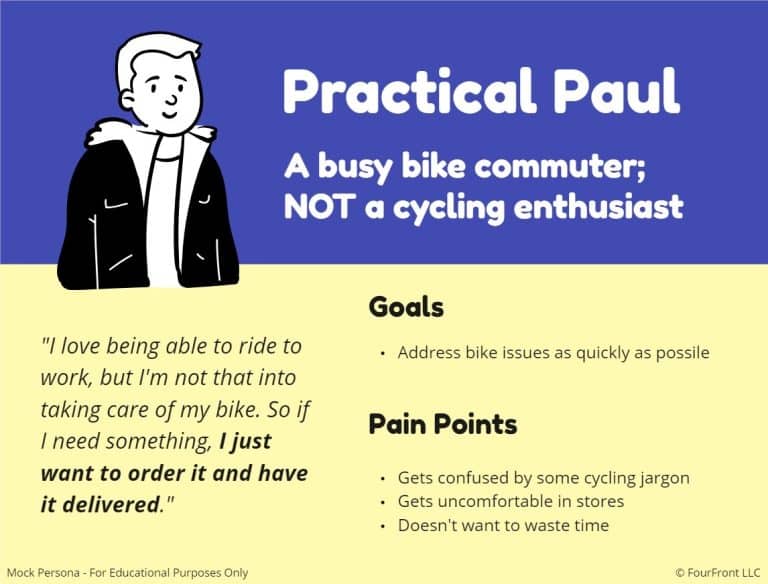
-
Tip: Use a fun name for your personas.
It might feel slightly childish, but there’s no way it will be as childish as those Avatar movies! * Plus, by naming the persona in the example above something like “Practical Paul,” you’ll create an easy shorthand that your teams can (a) remember, and (b) more easily reference over time.
It’s best practice to keep these personas as “living documents,” too. User needs change over time and successful companies continually research their users and update strategies accordingly. So be sure to save your working files and revisit them (and then recirculate them) when you have new data to integrate.
*I just want to state for the record, I actually enjoy the Avatar movies. They are just an easy target! 😊 I also highly recommend the “Flight of Passage” Avatar ride in Disney World. I’m not that into rides but it’s easily the best “simulator” ride I’ve ever experienced.
User Personas vs. Audience Segments
Since this is a post for digital marketers, I want to quickly address how this technique might compare to other audience definition exercises common to marketing.
Both are a stand-in for real-life users or customers. A persona might represent/complement an audience segment, but they are not quite the same thing because of the goals behind each effort:
- Personas are meant to humanize an audience to assist with user-centered decision-making (which is often the purview of UX designers and product managers).
- Audience segments are used to divide a target market, usually for targeted advertising or other marketing efforts (hence the popularity among marketing professionals).
Similarities include:
- Both represent a broader target audience and help with defining goals, paint points, demographics, and other unique identifiers.
- Both are used to guide teams in making decisions.
An Audience Segment is different from a persona in a few key ways:
- Segments are typically concrete in their descriptions, while personas regularly use narrative and emotional attributes to describe the audience.
- Segments are typically focused only on quantitative data, while user personas are traditionally derived from user research. (Though both can—and should! —use both qualitative and quantitative data.)
In my opinion, marketers will be most successful when drawing from the best of both worlds. For example, we use personas at FourFront based on both qualitative inputs like user interviews or stakeholder feedback plus quantitative data like keyword research and Google Analytics data. (I have a Medium post that quickly explores the difference between quant and qual data, if you’re interested.)
How to Build a User Persona
Here are some basic steps to get started.
1. Collect your data and any remaining assumptions.
This is the first step because a strong persona should come after you’ve completed at least some basic research and/or data analysis. Collect these insights and start to sort them into groups.
2. Define the content.
You need to decide (A) how many personas you want to define, and (B) what attributes you want to highlight. Common attributes include demographics (such as geographic location, age, family, education), behavioral or psychographic attributes (like interests or habits), and user experience criteria that related directly to your product, service or website (think: goals, needs, pain points).
3. Design your visual.
The key to turn this into a team-friendly deliverable is to visualize your content in a compelling, clear way. Cloud-based, collaborative tools like Figma and Canva have become the standard for creating these types of graphics, and you can find many, many templates and starting points to help expedite the process. You can also start from scratch, or use higher-fidelity tools like Adobe Photoshop or Illustrator if desired.
4. Share your work and get feedback.
Be sure to make your personas widely available on your teams. It’s best practice to also field questions or other feedback to ensure alignment of understanding and to catch important details that may have been missed.
5. Set reminders to revisit the persona.
Use your team’s project management tool to ensure these get revisited in the future. (If you don’t have a PM tool, set a calendar reminder for yourself.) Learnings will happen all the time, and it’s important to repeat this process regularly. This can also be a great touchpoint on your team to help encourage user-centered decision making over time.
User Personas in Practice
One example in which our team at FourFront put user personas to good use was during a volunteer hackathon called 2023 Launchpad hosted by Code for Philly. Over 5 weeks, our team aimed to design an open source technology solution to help Philadelphians connect at events hosted in “third places” around the community (here’s an explainer on that powerful concept).
During the kickoff weekend, the team spoke with various stakeholders to understand the pain points of various people who would interact with the system we designed. As we started making decisions about th strategy and functionality of our app, we had a lot of ideas but knew everything wouldn’t be possible. So we thought it was important to document what we knew so far about our stakeholders as user personas. This resulted in the 4 distinct personas are shown below: 2 for event attendees, and 2 for event hosts.
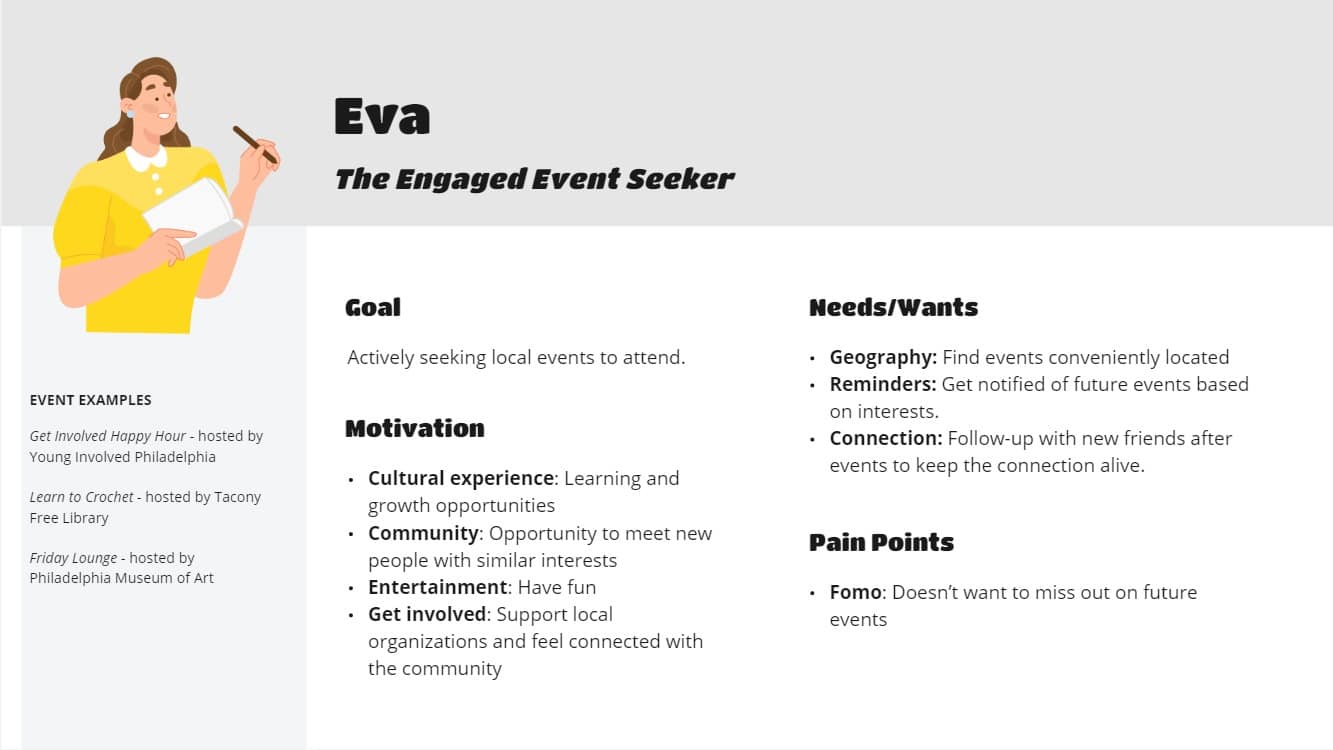
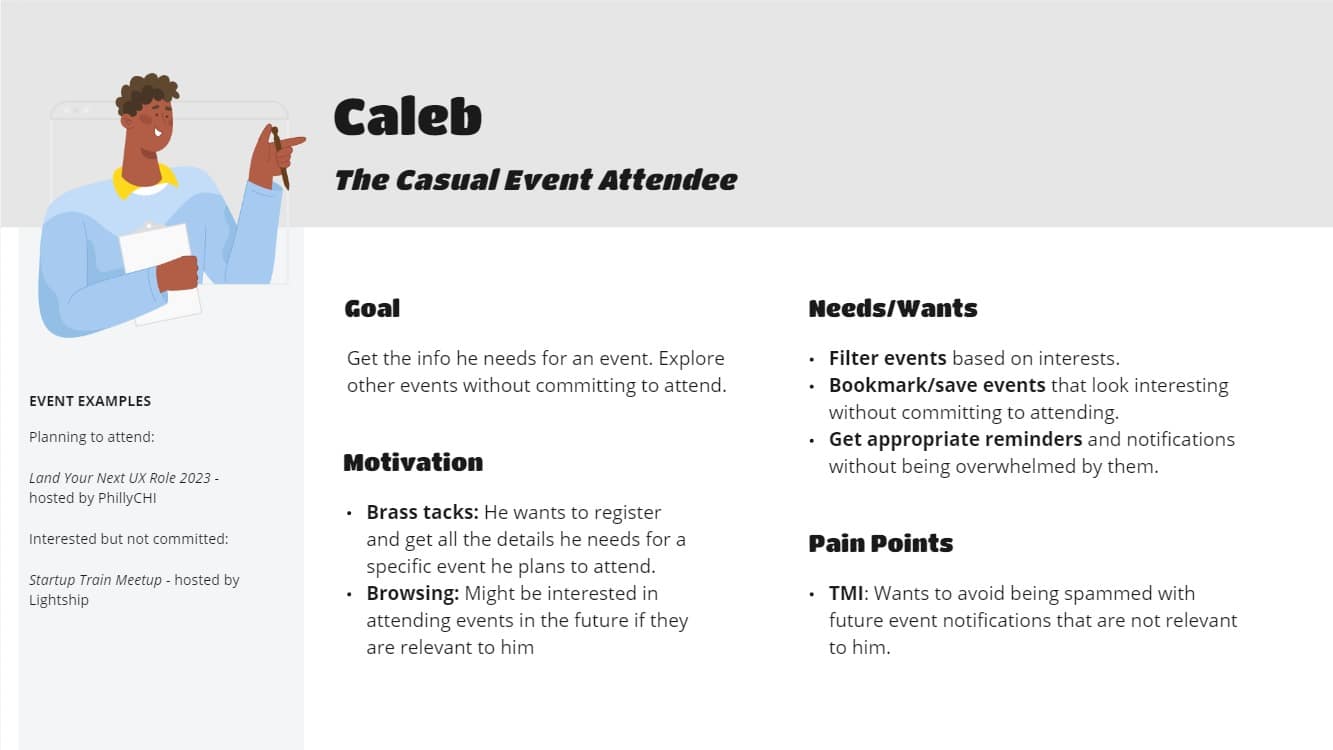
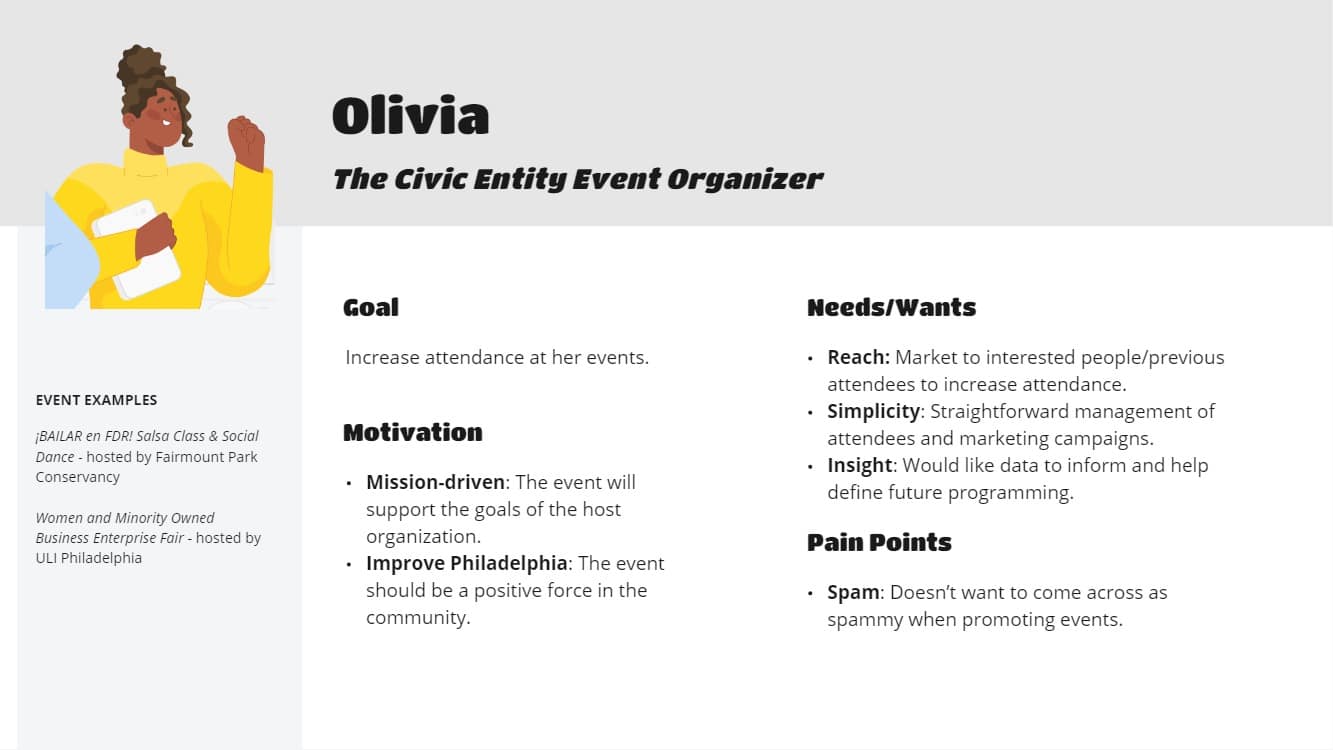
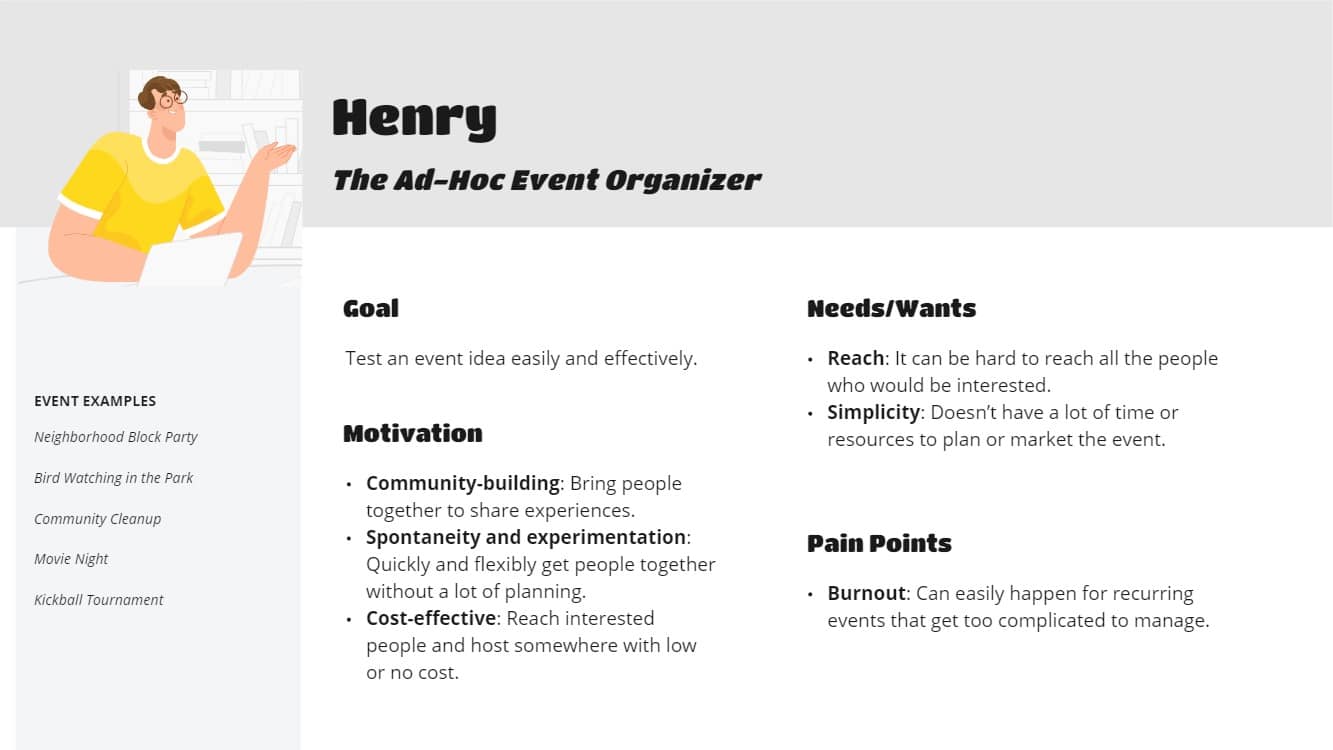
Ideally, we would have loved to have more time to do additional user research to continue to refine these. But we felt these provided a great foundation for future iteration, plus they helped us make quick decisions to get to a strong final concept and even a functioning prototype powered by OpenAI’s GPT3 API.
For example, our personas emphasize Eva’s need for reminder notifications but also Caleb’s aversion to feeling like he’s being spammed by too many notifications, not to mention Olivia’s desire on the host side to avoid bugging anyone. All of these insights point to the need to prioritize customizable notification settings in the product roadmap.
Armed with these insights, future iterations of this project will be that much closer to launching a strong product.
Types of User Personas
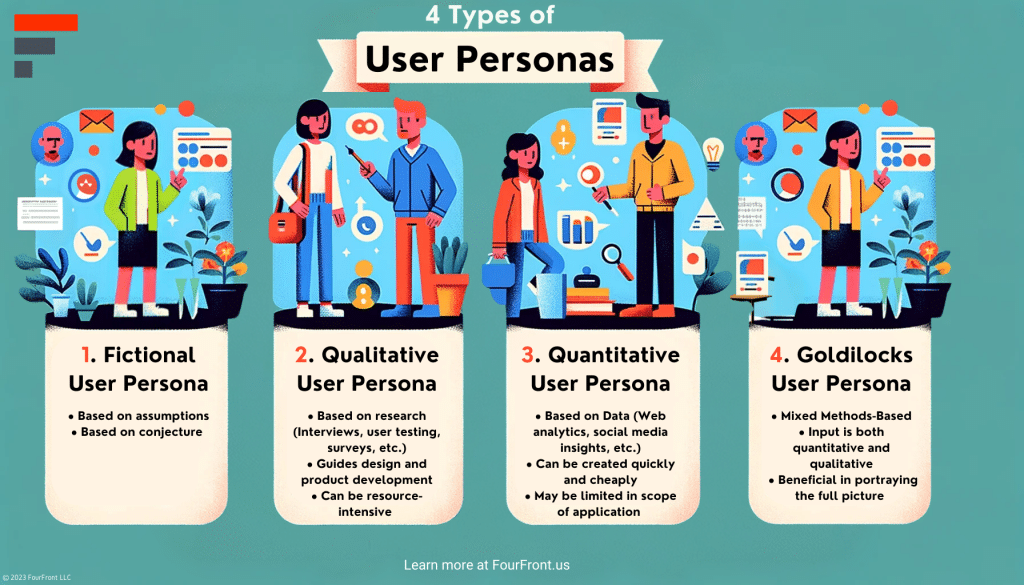
There are few typical User Persona styles that we should quickly address. I’m going to start with the worst one, which is where many teams will probably start:
Fictional User Personas (Assumption-Based)
A fictional persona is based purely on conjecture and assumption.
It’s okay to start here. But it’s crucial that your team understands that this is not a true persona. Be sure to clearly label your assumptions and make a plan on how you will test them over time.
Note: This is the persona type you should assume a generative AI tool will be able to give you. There are basic prompts to get ChatGPT and other tools to output a basic persona, but keep in mind that what it gives you should be a starting point that you then confirm with data.
- A caveat: If you provide your evidence to ChatGPT within your prompt, then the persona will be based on actual evidence and can be considered a stronger UX deliverable. Make sense?
Qualitative User Persona (User Research-Based)
Most UX professionals’ default to thinking about this type of persona, which is based on tried-and-true user research methods like interviews, user testing, surveys, and more.
This is a fantastic style for creating narrative-focused personas that will guide design and product development decisions. The drawback is that user research can be resource-intensive (i.e. expensive).
Quantitative User Persona (Data-Based)
You might consider this an Audience Segment that has been visualized, which is a great way to make your quantitative data more relatable. Startups and teams without user research resources are likely to create these based on whatever data they can find, like website analytics or social media insights.
These can be created quickly and cheaply, but depending on the data you have, they may be limited in scope of application. It’s also important to recognize that quant data gives you a good, broad picture—but without speaking to real people, it’s impossible to know the “why” behind their actions or to really understand the story behind the data.
Goldilocks User Personas (Mixed Methods-Based)
As you might have guessed, here is a “the third one was just right” style: If you can create a Goldilocks persona that is based on both quantitative and qualitative input, then you’ll truly have the best of both worlds.
For example, you might know from surveys that certain types of people are less likely to order bike parts from an ecommerce website. But until you spoke with them, you might not have realized that it’s because one particular audience doesn’t trust packages to be left on their front porch (I’m making this up). With that insight, you can paint a fuller picture of each group and hone your strategy accordingly.
Trusted Experts in User Research
I hope this guide has given you a good foundation for creating more beneficial personas in your digital marketing work. With the basics laid out here, you should be well-equipped to create intelligent personas that make a big impact on your work and your collaboration with other team members.
The best way to get better is to practice, so go give it a try! Do let me know if you have success, or any other questions or comments, in the discussion below. You can also reach out to our team at FourFront to discuss deeper partnership opportunities on user research, data analytics, or digital content strategy.
Reach out to FourFront now to elevate your brand’s online presence and drive results!
Ready to leverage user personas to optimize your digital marketing and SEO strategies?
Request a Free Consultation









